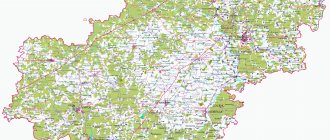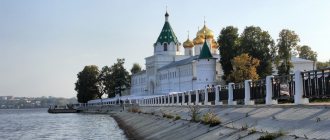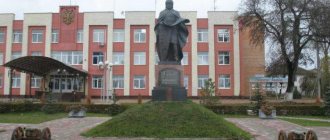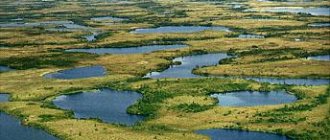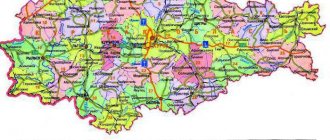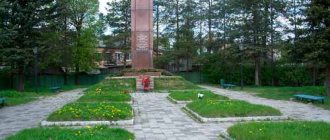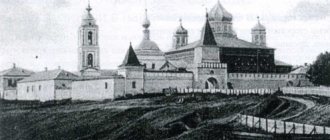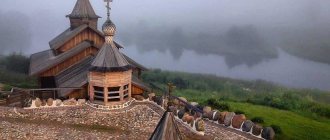It should not be confused with the Przemysl region, which existed in 1929-1963.
| district/municipal area | |
| Przemysl district | |
| Flag | Coat of arms |
- (1.32%, 16th place)
Przemysl district
- administrative-territorial unit (district) and municipal formation (municipal district) in the Kaluga region of Russia.
The administrative center is the village of Przemysl.
What holiday is it today?
December 16, 2021, Thursday
Today are holidays, events: Events that happened on December 16 in the world, in different years Tomorrow: Day of Strategic Missile Forces Day of Employees of the State Courier Service Memorable date in the military history of Russia: Capture of the Ochakov fortress in 1788
Today is the Orthodox holiday of the Prophet Zephaniah. Reverend Savva of Storozhevsky, Zvenigorod. Martyr Angelis... Tomorrow: Great Martyr Barbara and Martyr Juliania of Iliopolis. Venerable John of Damascus...
Today is a national holiday: Day of World Silence and Silence... Tomorrow: Barbarian Day...
Population
| Population | ||||||
| 1931[5] | 1939[6] | 1959[7] | 1970[8] | 1979[9] | 1989[10] | 2002[11] |
| 49 187 | ↘37 858 | ↘24 421 | ↘23 490 | ↘18 343 | ↘16 105 | ↘13 952 |
| 2009[12] | 2010[13] | 2011[14] | 2012[15] | 2013[16] | 2014[17] | 2015[18] |
| ↘11 898 | ↗14 137 | ↘14 043 | ↘13 694 | ↘13 531 | ↘13 375 | ↗13 540 |
| 2016[19] | 2017[20] | 2018[21] | 2019[22] | 2020[2] | ||
| ↗13 687 | ↗13 861 | ↘13 670 | ↘13 277 | ↘13 206 | ||
Seasons
Seasons, four periods of the year (spring, summer, autumn and winter) characterized by certain average temperatures. The period during which the Sun passes through one of these sectors is called the season. Spring in the Northern Hemisphere and autumn in the Southern Hemisphere begin when the Sun passes through the initial circle of declination and its right ascension is 0° (vernal equinox). Summer in the Northern Hemisphere and winter in the Southern Hemisphere occur when the sun's right ascension is 90° (summer solstice). Autumn in the Northern Hemisphere and spring in the Southern Hemisphere begin when the sun's right ascension is 180° (autumnal equinox). The beginning of winter in the Northern Hemisphere and summer in the Southern Hemisphere is considered to be the winter solstice, when the direct ascension of the Sun is 270°... Next: Seasons. Russian folk calendar. Monthly words...
Folk calendar about every day
Every day one season always replaces another and this determines a person’s way of life. In connection with this, a folk calendar was formed in which there were practically no nameless, unmarked days. Every day was special, had its own purpose. All this was determined by climate conditions and astrological phenomena.
A calendar is a system for counting periods of time. The first calendars arose a long time ago, in ancient times, because there was a need to measure time. The word calendar comes from the Latin words caleo - to proclaim and calendarium - debt book. This is due to the fact that in Ancient Rome the beginning of each month was especially proclaimed, and because it was customary to pay debts on the first day of the month. Different peoples counted time differently. Some calendars are based on the changing phases of the moon - lunar calendars; in others - the change of seasons - sunny; in others, the length of the year was coordinated with the change of seasons, and the counting of months was associated with the phases of the Moon. Such calendars are called lunisolar.
In Rus', the calendar was called a monthly calendar. Every day, the month book covered the entire year of peasant life, “describing” day by day, month after month, where each day had its own holidays or weekdays, customs and superstitions, traditions and rituals, natural signs and phenomena. The cyclical nature of the calendar is reminiscent of human life, where spring is youth, summer is heyday, autumn is the time of harvesting fruits (it’s good if there are some, otherwise you can live your life without collecting fruits), winter is the time of wisdom and peace. This cyclicality and rhythm determined the way of life of the farmer. The folk calendar was an agricultural calendar, which was reflected in the names of the months, folk signs, rituals and customs. Even the determination of the timing and duration of the seasons is associated with real climatic conditions. Hence the discrepancy between the names of the months in different areas... Next: Folk calendar...
Map of the Kaluga region with cities, districts and villages
| 1. Kaluga | 10. Khvastovichi s. (Khvastovichi district) | 19. Balabanovo city (Borovsky district) | 28. Belousovo city (Zhukovsky district) |
| 2. Meshchovsk city (Meshchovsky district) | 11. Elensky town (Khvastovichi district) | 20. Spas-Demensk city (Spas-Demensky district) | 29. Wears p. (Iznoskovsky district) |
| 3. Mosalsk city (Mosalsky district) | 12. Yukhnov city (Yukhnovsky district) | 21. Kondrovo city (Dzerzhinsky district) | 30. Zhukov city (Zhukovsky district) |
| 4. Medyn city (Medynsky district) | 13. Dudorovsky town (Ulyanovsk district) | 22. Borovsk city (Borovsky district) | 31. Zhizdra city (Zhizdra district) |
| 5. Lyudinovo city (Lyudinovo district) | 14. Ulyanovo village (Ulyanovsk district) | 23. Baryatino village (Baryatinsky district) | 32. Tovarkovo rp (Dzerzhinsky district) |
| 6. Betlitsa pst (Kuibyshevsky district) | 15. Seredeysky town (Sukhinichi district) | 24. Obninsk | 33. Duminichi pst (Duminichi district) |
| 7. Przemysl village (Przemysl district) | 16. Tarusa city (Tarussky district) | 25. Babynino pst (Babyninsky district) | 34. Kozelsk city (Kozelsky district) |
| 8. Maloyaroslavets city (Maloyaroslavets district) | 17. Sosensky city (Kozelsky district) | 26. Kurovsky district (Dzerzhinsky district) | |
| 9. Sukhinichi city (Sukhinichsky district) | 18. Kirov city (Kirovsky district) | 27. Pyatovsky district (Dzerzhinsky district) |
Satellite map of the Kaluga region
Switching between the satellite map of the Kaluga region and the schematic one is done in the lower left corner of the interactive map.
Kaluga region - Wikipedia:
Date of formation of the Kaluga region:
July 5, 1944
Population of the Kaluga region:
1,000,980 people.
(January 1, 2021) Telephone code of the Kaluga region:
484
Area of the Kaluga region:
29,800 km²
Vehicle code of the Kaluga region:
40
Districts of Kaluga region:
Babyninsky • Baryatinsky • Borovsky • Dzerzhinsky • Duminichsky • Zhizdrinsky • Zhukovsky • Iznoskovsky • Kirovsky • Kozelsky • Kuibyshevsky • Lyudinovsky • Maloyaroslavetsky • Medynsky • Meshchovsky • Mosalsky • Peremyshl • Spas-Demensky • Sukhinichsky • Tarussky • Ulyanovsky • Ferzikovsky • Khvastovichsky • Yukhnovsky.
Cities of the Kaluga region - list of cities in alphabetical order:
Population of the Kaluga region in 2021.
Balabanovo city
founded in 1584.
The population of the city is 25,752 people. The city of Belousovo
was founded in 1962.
The population of the city is 9288 people. The city of Borovsk
was founded in 1358.
The population of the city is 10966 people. The city of Ermolino
was founded in 1601.
The population of the city is 10,158 people. The city of Zhizdra
was founded in 1146.
The population of the city is 5489 people. The city of Zhukov
was founded in the 17th century.
The population of the city is 13251 people. The city of Kaluga
was founded in 1371.
The population of the city is 341,892 people. The city of Kirov
was founded in 1745.
The population of the city is 30,839 people. The city of Kozelsk
was founded in the 12th century.
The population of the city is 16,370 people. The city of Kondrovo
was founded in 1615.
The population of the city is 15017 people. The city of Kremenki
was founded in the 18th century.
The population of the city is 10,692 people. The city of Lyudinovo
was founded in 1626.
The population of the city is 38,846 people. The city of Maloyaroslavets
was founded in 1402.
The population of the city is 27,791 people. The city of Medyn
was founded in 1386.
The population of the city is 8032 people. The city of Meshchovsk
was founded in 1238.
The population of the city is 4037 people. The city of Mosalsk
was founded in 1231.
The population of the city is 4161 people. The city of Obninsk
was founded in 1946.
The population of the city is 113,639 people. The city of Sosensky
was founded in 1952.
The population of the city is 11047 people. The city of Spas-Demensk
was founded in 1446.
The population of the city is 4357 people. The city of Sukhinichi
was founded in the 18th century.
The population of the city is 15111 people. The city of Tarusa
was founded in 1246.
The population of the city is 9302 people. The city of Yukhnov
was founded in 1410. The population of the city is 6079 people.
Kaluga region
- Russian region with a regional center in the city of
Kaluga
, which is located at a distance of 150-200 km. from Moscow. The Kaluga region has an advantageous geographical location, through which the main highways pass. Kaluga lands have an ancient and rich history. The regional center of Kaluga was first mentioned in 1371.
Kaluga is considered the “Cradle of Cosmonautics”, as Russian scientist Konstantin Tsiolkovsky worked and lived there. Obninsk is a science city, home to the world's first civilian nuclear power plant and a 315-meter-high meteorological tower.
Maloyaroslavets is famous for the battle that took place here in October 1812 against Napoleon, which forced him to abandon his attempt to leave Russia through Kaluga. Kozelsk is famous for the defense of the city against Batu Khan in 1238 during the Mongol-Tatar invasion of Rus'.
Borovsk is best known for its connections with the Old Believer movement. The city of Tarusa on the Oka River is best known for its connection with the poetess Marina Tsvetaeva, and Konstantin Paustovsky, who lived in this city.
In the Kaluga region of Russia there are many nature reserves and national parks that are of federal significance. The largest ones are Kaluga Zaseki, Ugra, Tarusa, etc. Kaluga is a city that is also interesting to visit. The city's architecture is civil, with buildings dating back to the 18th and 19th centuries. It is also worth visiting the city museums, the collections of which are unique: the Tsiolkovsky Museum, the Museum of Local Lore, etc.
Fishing calendar for every day
The fishing calendar should not be taken as an absolutely indisputable truth. Fish biting is greatly influenced by a whole range of natural factors, as well as the influence on the nature of man himself. You must not forget that the fish’s bite depends and is determined not only by the calendar dates and biological cycles of their life, reflected in the calendar, but also, no less, by the state of their habitat; the bite also depends on weather conditions: air and water temperatures, cloudiness, wind direction and strength, etc... Next: Fishing calendar...
Orthodox calendar about every day
Orthodox calendar: Orthodox, Church and Christian holidays.
The church year is an alternation of weekdays and holidays. On weekdays, a person is called to work “by the sweat of his brow to earn his bread.” Holidays are given in order to feel liberation, to rise above the bustle and routine of the world, to feel involved in the highest of worlds, “where there are no illnesses, sorrows and sighs, but endless life.” Since ancient times, holiday cycles have been associated with the seasons. The pagans associated them with the worship of the forces of nature, the cult of which in the Old Testament was replaced by gratitude to the Creator for the universe. And although the connection between holidays and the seasons has not completely lost its power, since God is present in everything, in the plant and animal world, in human works, it nevertheless faded into the background, giving way to a spiritual foundation built on the Sacred Scriptures. The history of Orthodox holidays dates back to the times of the Old Testament. Each of the Orthodox holidays is dedicated to the remembrance of the most important events in the life of Jesus Christ and the Mother of God, as well as the memory of saints... Next: Orthodox calendar...
Attractions
The village of Borishchevo in the Peremyshl region is the birthplace of the Chelyuskin family. Polar explorer Semyon Ivanovich Chelyuskin was born in Borishchevo. The village of Orlya with an ancient church dating from 1750 is 2 km away.
On the territory of the district there is also an important archaeological monument - the village of Vorotynsk, which is mentioned in the Ipatiev Chronicle in connection with the events of 1155.
Part of the Ugra National Park is located within the Peremyshlsky district of the Kaluga region.
The church in Grigorovsky was built in 1673 at the expense of the boyar Bogdan Khitrovo. The temple is named in honor of the Kazan Icon of the Mother of God, has the border of Demetrius of Thessalonica and a bell tower. The temple was closed in 1932. Returned to believers in 1996... It is being restored slowly, at the expense of local residents.
Western wing with a colonnade of the Konshin estate in the village of Akhlebinino.
Russian folk calendar for every day
The word “sign” comes from the word “notice”, i.e. observe. As a result of observing what happens around a person every day, he accumulates life experience. This knowledge was passed down from generation to generation, carefully preserved and people trusted it as a sacred book. Many signs have come to us from the depths of centuries without losing their knowledge. Each of us is free to choose: to dismiss all this as an absurd superstition or to take a closer look at the signs and take the centuries-old experience of generations more seriously. Most of us, when taking exams, ask them to scold them, boasting about some kind of good fortune or luck, spit so as not to jinx them or knock on wood, take a detour if a black cat crossed the road, are afraid of the number 13 and much more. And who among us does not have lucky things, numbers? Who has never resorted to the help of fate at least once in their life, who has not believed in secrets? It’s as if everything connected with signs is hidden somewhere deep in our subconscious. Often we remember them mechanically, unconsciously, or just as a joke. But, undoubtedly, the signs contain a lot of accurate knowledge and practical wisdom of our ancestors. They cover all the characteristic, often difficult to perceive, natural phenomena. Signs have preserved a lot of what was in old folk holidays and customs; they help predict the weather, grow crops... Next: Folk signs...
Administrative division
The Przemysl district as an administrative-territorial unit includes 16 administrative-territorial units: 8 villages and 8 hamlets[23][24], as a municipal entity with the status of a municipal district - 16 municipalities with the status of rural settlements[25].
| № | Rural settlements | Administrative center | Number of settlements | Population | Area, km2 |
| 1 | Village Big Goats | Bolshiye Kozly village | 12 | ↗976[2] | 190,31[1] |
| 2 | Gorki village | Gorki village | 8 | ↘959[2] | 57,52[1] |
| 3 | Village Grigorovskoe | Grigorovskoe village | 19 | ↘317[2] | 93,00[1] |
| 4 | Pesochnya Village | Pesochnya village | 11 | ↗195[2] | 74,08[1] |
| 5 | Pogorelovka village | Pogorelovka village | 5 | ↘241[2] | 33,81[1] |
| 6 | Village Pokrovskoye | Pokrovskoye village | 11 | ↘512[2] | 65,35[1] |
| 7 | Village Silkovo | Silkovo village | 10 | ↘765[2] | 63,72[1] |
| 8 | Khotishino village | Khotisino village | 12 | ↗391[2] | 67,62[1] |
| 9 | Village Akhlebinino | Akhlebinino village | 7 | ↘1047[2] | 57,16[1] |
| 10 | Village Borishchevo | Borishchevo village | 4 | ↘225[2] | 51,36[1] |
| 11 | Village Gremyachevo | Gremyachevo village | 4 | ↘318[2] | 37,61[1] |
| 12 | Village Ilyinskoye | village Ilyinskoye | 8 | ↗360[2] | 64,97[1] |
| 13 | Village Kaluga experimental agricultural station | village Kaluzhskaya experimental agricultural station | 10 | ↘1452[2] | 61,28[1] |
| 14 | Korekozevo village | Korekozevo village | 8 | ↗1152[2] | 77,75[1] |
| 15 | Village Makarovo | village Makarovo | 14 | ↘402[2] | 91,45[1] |
| 16 | Village of Przemysl | village of Przemysl | 4 | ↘3894[2] | 40,48[1] |
By the Law of the Kaluga Region of May 29, 2009 No. 551-OZ[26], the rural settlements “Peremyshl Village” and “Khokhlovka Village” were united into the rural settlement “Peremyshl Village” with the administrative center in the village of Peremyshl.
Settlements
There are 147 settlements in the Przemysl region.
| List of settlements in the region | ||||
| № | Locality | Type | Population | Municipality |
| 1 | Akinshino | village | ↘13[13] | Village Grigorovskoe |
| 2 | Alekseevka | village | ↘0[13] | Pesochnya Village |
| 3 | Alekseevskoe | village | ↘1[13] | Village Grigorovskoe |
| 4 | Antipovka | village | →3[13] | Khotishino village |
| 5 | Afanasyevo | village | ↘6[13] | Village Pokrovskoye |
| 6 | Akhlebinino | village | ↘957[13] | Village Akhlebinino |
| 7 | Basovo | village | ↗10[13] | Village Makarovo |
| 8 | White | village | ↗9[13] | Village Grigorovskoe |
| 9 | Beaver | village | ↘0[13] | Khotishino village |
| 10 | Lateral | village | ↘3[13] | Khotishino village |
| 11 | Big Goats | village | ↗782[13] | Village Big Goats |
| 12 | Big Drying | village | ↘6[13] | Village Big Goats |
| 13 | Borisovka | village | ↘12[13] | Pesochnya Village |
| 14 | Borishchevo | village | ↘240[13] | Village Borishchevo |
| 15 | Bragino | village | ↗29[13] | Village Makarovo |
| 16 | Budakovo | village | ↗25[13] | Village Big Goats |
| 17 | Bukreevo | village | ↘1[13] | Village Gremyachevo |
| 18 | Bushovka | village | ↗12[13] | Korekozevo village |
| 19 | Vasilenki | village | ↗69[13] | Village Grigorovskoe |
| 20 | Verkhnee Alopovo | village | ↗30[13] | Village Pokrovskoye |
| 21 | Verkhneye Kosmovo | village | ↘11[13] | Village Akhlebinino |
| 22 | Verkhniye Vyalitsa | village | ↘30[13] | Village Ilyinskoye |
| 23 | Upper Podgorichi | village | ↗107[13] | Village Silkovo |
| 24 | Eternal | village | ↘30[13] | Village Grigorovskoe |
| 25 | Volnya | village | ↘5[13] | Korekozevo village |
| 26 | Vorobyovka | village | ↘11[13] | Gorki village |
| 27 | Voronovo | village | ↘21[13] | Korekozevo village |
| 28 | Vorotynsk | village | ↗168[13] | Village Kaluga experimental agricultural station |
| 29 | Golovnino | village | ↘68[13] | Village Silkovo |
| 30 | Golodskoye | village | ↘36[13] | Korekozevo village |
| 31 | Golcanj | village | ↘19[13] | Korekozevo village |
| 32 | Gordikovo | village | ↗26[13] | Village Ilyinskoye |
| 33 | Gorki | village | ↗947[13] | Gorki village |
| 34 | Gremyachevo | village | ↘255[13] | Village Gremyachevo |
| 35 | Grigorovo | village | ↘3[13] | Village Pokrovskoye |
| 36 | Grigorovskoe | village | ↘190[13] | Village Grigorovskoe |
| 37 | Gridnevo | village | ↘2[13] | Pesochnya Village |
| 38 | Gritskoe | village | ↗18[13] | Village Silkovo |
| 39 | Gulevo | village | ↗36[13] | Village Makarovo |
| 40 | Dementeevka | village | →10[13] | Gorki village |
| 41 | Dudorovka | village | Village Silkovo | |
| 42 | Elizabeth | village | ↘1[13] | Village Big Goats |
| 43 | Elovka | village | ↗67[13] | Village Big Goats |
| 44 | Ermashovka | village | ↘11[13] | Village Ilyinskoye |
| 45 | Ershovka | village | ↘5[13] | Gorki village |
| 46 | Zhashkovo | village | ↗63[13] | Village of Przemysl |
| 47 | Zhdanovka | village | ↗10[13] | Pogorelovka village |
| 48 | Zhelovsky Forestry | village | ↘4[13] | Village Grigorovskoe |
| 49 | Zhelov | village | ↗8[13] | Village Big Goats |
| 50 | Zhelokhovo | village | ↗76[13] | Village Silkovo |
| 51 | Zabelino | village | ↘19[13] | Village Makarovo |
| 52 | Zabolotye | village | ↗54[13] | Village Kaluga experimental agricultural station |
| 53 | Zaborovka | village | ↗75[13] | Village Kaluga experimental agricultural station |
| 54 | Zelenino | village | ↘21[13] | Village Grigorovskoe |
| 55 | Zenilovo | village | ↘5[13] | Village Makarovo |
| 56 | Zimnitsa | village | ↘80[13] | Village Gremyachevo |
| 57 | Chills | village | →6[13] | Pesochnya Village |
| 58 | Ignatovskoe | village | ↘20[13] | Village Grigorovskoe |
| 59 | Ilyinka | village | ↗2[13] | Village Big Goats |
| 60 | Ilyinskoe | village | ↗237[13] | Village Ilyinskoye |
| 61 | Istomino | village | ↘3[13] | Village Makarovo |
| 62 | Kaluga Experimental Agricultural Station | village | ↘1273[13] | Village Kaluga experimental agricultural station |
| 63 | Kaluga Geological Exploration Party | village | ↘30[13] | Village Kaluga experimental agricultural station |
| 64 | Karaulovka | village | ↗6[13] | Village Makarovo |
| 65 | Kireevo | village | ↘10[13] | Korekozevo village |
| 66 | Kirilovskoe | village | ↘8[13] | Village Grigorovskoe |
| 67 | Kozhemyakino | village | ↗12[13] | Village Pokrovskoye |
| 68 | Kolyshevo | village | ↗5[13] | Pogorelovka village |
| 69 | Komsino | village | ↘5[13] | Village Pokrovskoye |
| 70 | Konstantinovka | village | ↘10[13] | Village Grigorovskoe |
| 71 | Korekozevo | village | ↘1041[13] | Korekozevo village |
| 72 | Korchevskie Dvoriki | village | ↗7[13] | Village Pokrovskoye |
| 73 | Krasnikovo | village | ↘4[13] | Village Grigorovskoe |
| 74 | Kremenevo | village | ↘7[13] | Pesochnya Village |
| 75 | Krutitsy | village | ↗9[13] | Village Big Goats |
| 76 | Steep Tops | village | ↗4[13] | Village Big Goats |
| 77 | Kudinovo | village | →0[13] | Village Ilyinskoye |
| 78 | Kuzmenki | village | ↘2[13] | Village Grigorovskoe |
| 79 | Kulnevo | village | ↘2[13] | Gorki village |
| 80 | Kurovo | village | ↘10[13] | Pesochnya Village |
| 81 | Ladygino | village | ↘41[13] | Gorki village |
| 82 | Lomokhino | village | ↗3[13] | Khotishino village |
| 83 | Luchkino | village | ↘10[13] | Village Kaluga experimental agricultural station |
| 84 | Makarovo | village | ↘357[13] | Village Makarovo |
| 85 | Malaya Slobodka | village | ↘12[13] | Village Kaluga experimental agricultural station |
| 86 | Small Goats | village | ↗32[13] | Village Big Goats |
| 87 | Malyutino | village | ↘6[13] | Village Grigorovskoe |
| 88 | Mehoho | village | ↘57[13] | Korekozevo village |
| 89 | Mitinka | village | ↘2[13] | Village Grigorovskoe |
| 90 | Mikhailovskoe | village | ↘19[13] | Village Pokrovskoye |
| 91 | Morozovy Dvory | village | →2[13] | Village Big Goats |
| 92 | Morhani | village | ↘2[13] | Khotishino village |
| 93 | Men | village | ↗25[13] | Village Big Goats |
| 94 | Muratovka | village | ↗2[13] | Village Makarovo |
| 95 | Nelyubovskoe | village | ↘8[13] | Village Grigorovskoe |
| 96 | Nizhnee Alopovo | village | ↘76[13] | Village Pokrovskoye |
| 97 | Nizhne Kosmovo | village | →4[13] | Village Akhlebinino |
| 98 | Nizhnye Vyalytsia | village | ↗4[13] | Village Ilyinskoye |
| 99 | Lower Podgorichi | village | ↘20[13] | Village Silkovo |
| 100 | Nikitinka | village | →0[13] | Village Grigorovskoe |
| 101 | Nikitya | village | →2[13] | Pesochnya Village |
| 102 | Nikolaevka | village | ↘23[13] | Village Akhlebinino |
| 103 | Nikolskoye | village | ↘86[13] | Village Akhlebinino |
| 104 | Nikolskoye | village | ↘0[13] | Village Makarovo |
| 105 | Novoselki | village | →15[13] | Village Silkovo |
| 106 | Novoselki | village | ↗2[13] | Village Makarovo |
| 107 | Oberegaevka | village | ↘0[13] | Village Makarovo |
| 108 | Orlya | village | ↘2[13] | Village Borishchevo |
| 109 | Przemysl | village, administrative center | ↗3279[13] | Village of Przemysl |
| 110 | Sands | village | ↘1[13] | Pesochnya Village |
| 111 | Sandbox | village | ↗172[13] | Pesochnya Village |
| 112 | Petrovskoe | village | ↘17[13] | Pogorelovka village |
| 113 | Petropavlovo | village | →2[13] | Khotishino village |
| 114 | Pogorelovka | village | ↗177[13] | Pogorelovka village |
| 115 | Podkorie | village | ↘4[13] | Khotishino village |
| 116 | Pokrovskoye | village | ↘304[13] | Village Pokrovskoye |
| 117 | Glade | village | ↘390[13] | Village of Przemysl |
| 118 | Prudishchi | village | →11[13] | Gorki village |
| 119 | Pushkino | village | ↘13[13] | Village Akhlebinino |
| 120 | Razdol | village | ↘10[13] | Village Gremyachevo |
| 121 | Springs | village | Village Borishchevo | |
| 122 | Christmas | village | ↘7[13] | Khotishino village |
| 123 | Ryczenki | village | ↘39[13] | Gorki village |
| 124 | Ryadovka | village | ↗127[13] | Village Pokrovskoye |
| 125 | Ryadovo | village | →1[13] | Village Kaluga experimental agricultural station |
| 126 | cages | village | ↘26[13] | Village Borishchevo |
| 127 | Saltanovskoe | village | ↘13[13] | Village Grigorovskoe |
| 128 | Samoilovo | village | →2[13] | Pesochnya Village |
| 129 | Semyonovka | village | ↘4[13] | Pesochnya Village |
| 130 | Silkovo | village | ↗429[13] | Village Silkovo |
| 131 | Sinyatino | village | ↗30[13] | Pogorelovka village |
| 132 | Slevidovo | village | ↗3[13] | Village Kaluga experimental agricultural station |
| 133 | Average Factory | village | ↘7[13] | Village Akhlebinino |
| 134 | Stolpovo | village | ↘8[13] | Village Kaluga experimental agricultural station |
| 135 | Tatievo | village | ↘8[13] | Village Silkovo |
| 136 | Temerevo | village | ↗10[13] | Village Makarovo |
| 137 | Toropovo | village | ↗83[13] | Village Silkovo |
| 138 | Manor | village | →0[13] | Khotishino village |
| 139 | Fitinino | village | ↘12[13] | Khotishino village |
| 140 | Hills | village | ↘6[13] | Khotishino village |
| 141 | Khotishino | village | ↗352[13] | Khotishino village |
| 142 | Khokhlovka | village | ↗318[13] | Village of Przemysl |
| 143 | Garlics | village | ↗5[13] | Village Grigorovskoe |
| 144 | Shilnikovo | village | ↘4[13] | Village Makarovo |
| 145 | Shchepikhino | village | ↗7[13] | Village Pokrovskoye |
| 146 | Yupinka | village | ↘4[13] | Village Ilyinskoye |
| 147 | Yastrebovo | village | ↗27[13] | Village Ilyinskoye |
Holiday calendar, dates and events of the year
All state and professional holidays in Russia, including significant World and International holidays, and other equally interesting holidays and events about every day.
The holiday has always kept pace with the history of mankind. Social time can be divided into three types: everyday life (weekdays), weekends and holidays. Everyday life is a series of practices repeated day after day and every day (work). Weekends are regular breaks from the rush of everyday life. It is believed that on weekends a person should restore his strength after working days. Day off, non-working day. A holiday is a day of celebration established in honor or in memory of someone or something. A day or series of days celebrated by the church in memory of a religious event or saint... Next: Calendar...
Prayer book, Orthodox prayers for every day
Prayer is the most powerful means for healing all illnesses - both physical and mental. Prayers can be laudatory or grateful, petitionary and repentant. If we have offended God, sinned, we must ask Him for forgiveness, that is, repent. Such prayers are called repentant prayers. If everything is fine with us, if we and our loved ones are healthy and prosperous, if we have a place to live, something to wear, something to eat, we must glorify and thank God for this. Such prayers are called praise or thanksgiving. If some misfortune, illness, trouble or need happens, you need to ask God for help. Such prayers are called petitionary... Next: Orthodox prayers...
Zodiac, astrological, eastern calendar. Zodiac signs
In ancient times, to establish the calendar, priests used knowledge of the positions of all the planets. Before the reform of Peter 1, the New Year was celebrated on the Day of the Autumn Equinox. On this day, according to ancient legend, the most peaceful treaty was concluded between the Great Race (ancient Slavs) and the Great Dragon (ancient Chinese) and it was approximately 7518 years ago... For the ancient Slavs, the calendar month corresponded to the lunar cycle from new moon to new moon, taking into account such Thus, the relationship of the entire annual cycle with astronomical and natural phenomena. There was no coherent calendar system. The main natural phenomena are still considered to this day to be the days of the solar equinox and solstice - the Slavic holidays Maslenitsa, Kupala, Ovsen and Kolyada. But during the time of Peter 1, all ancient Slavic calendars were abolished and a new Western European calendar from the Nativity of Christ (Julian calendar) was introduced, while the beginning of the calendar was moved to January 1. The Julian calendar (old style) did not take leap days into account and accumulated one extra day every 128 years. After the October Revolution in 1918, the Gregorian calendar (new style) was introduced in Russia, according to which an amendment of 13 days was introduced. The calendar of the ancient Slavs was based on two planets: the Sun and the Moon. And now they don’t use anything at all. The calendar has become static. There is no such thing as the calendar, it turns out, resting on some planet. Nobody even knows about it. There are just some standard numbers, there are months and holidays. The calendar is based on the Sun and Moon. Why is this so? Because these two luminaries influence the Earth. The Earth revolves around the Sun, and the Moon revolves around the Earth. And these two luminaries create the atmosphere on the planet. From here the calendar is built... Next: Astrological calendar...
Story
The district was formed on July 12, 1929 as Kaluga
as part of the Kaluga district of the Central Industrial Region (from June 3, 1929 - Moscow region) with its center in the city of Kaluga on most of the territory of the abolished Kaluga district of the Kaluga province. The district includes the following village councils:
- from Bebelevsky volost: Annensky, Bebelevsky, Voskresensky, Gorodensky, Kaluzhensky, Mityukovsky, Novoselivansky, Sukhinichisky, Fedosovsky
- from Vorotynsky volost: Vorotynsky, Golovninsky, Zaborovsky, Kozhukhovsky, Obukhovsky, Oreshkovsky, Rosyansky, Spassky, Stolpovsky
- from Lassalsky parish: Kosmovsky, Fetininsky
- from the Nekrasovsky volost: Akhlebinsky, Verkhne-Vyrsky, Georgievsky, Grabtsevsky, Grigorovsky, Domozhirovsky, Karachevsky, Kolkhoz-Organizatorsky, Kolyupanovsky, Mstikhinsky, Muzhachsky, Nikolsky, Pavlo-Vorotynsky, Pletnevsky, Podkorsky, Pokrovsky, Puchkovsky, Romodanovsky, Sushkinsky, Turyninsky, Khotisinsky, Chernosvitinsky, Shopinsky, Yastrebovsky
- from Pyatovsky volost: Vasilievsky, Gorbensky, Dvortsovsky, Kamelginsky, Karavaevsky, Kozlovsky, Lobanovsky, Lev-Tolstovsky, Frolovsky, Yuryevsky.
On May 20, 1930, the Usadsky s/s was transferred from the Detchinsky district to the Kaluga district.
On July 30, 1930, after the liquidation of the districts, the district came under direct subordination to the Moscow Region.
On March 20, 1931, Kurovsky, Makarovsky, Pererushevsky and Rusinovsky s/s were transferred from the abolished Ferzikovsky district to Kaluga. On May 11, the Muzhachsky s/s was abolished.
On April 10, 1932, the Rusinovsky s/s was transferred to the Aleksinsky district.
On February 21, 1935, Annensky, Akhlebinsky, Bebelevsky, Kosmovsky, Kurovsky, Makarovsky, Mityukovsky, Novoselivansky, Pererushevsky, Podkorsky, Pokrovsky, Fedosovsky, Fetininsky and Khotisinsky s/s were transferred from the Kaluga district to the newly formed Dugninsky district.
On March 31, 1936, Annensky s/s was returned from the Dugninsky district to Kaluga. On August 28, Akhlebinsky s/s was returned, on July 31, 1937 - Bebelevsky, Mityukovsky, Pokrovsky and Fedosovsky s/s.
On September 26, 1937, the Kaluga region became part of the newly formed Tula region[3].
On September 8, 1938, the city of Kaluga became a city of regional subordination, separated into an independent administrative and economic unit, remaining the center of the region.
Since July 5, 1944, the Kaluga region has been part of the newly formed Kaluga region.
On February 1, 1963, the district included parts of the territories of the abolished Babyninsky, Dzerzhinsky and Peremyshl districts[4].
On January 12, 1965, Babyninsky and Dzerzhinsky districts were restored.
On January 16, 1969, the center of the district was moved to Przemysl, and the district received its modern name.
Dream books online, interpretation of dreams
A dream book is nothing more than an interpreter of dreams and dreams, a translator of dreams. Since ancient times, people have been using dream books; dreams have always been given great importance, and people have often noticed the prophetic properties of some dreams. The dream book can become your faithful assistant every day and throughout your life, thanks to the dream interpreter you can always make the right decisions, the dream book will help you resist temptations in time, and will warn you against wrong steps and frivolous actions. Further…
